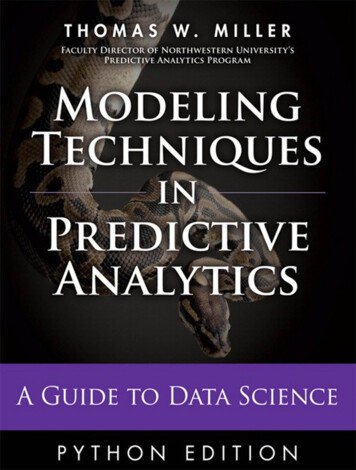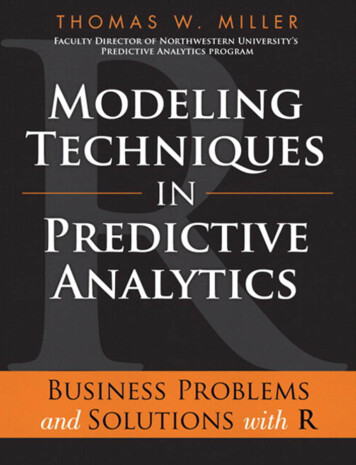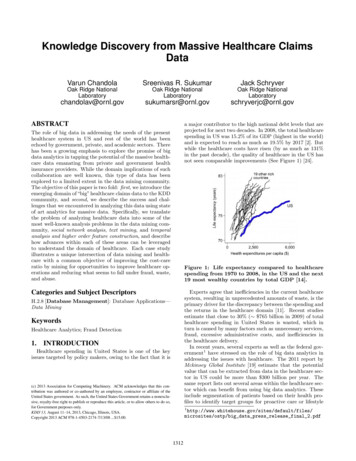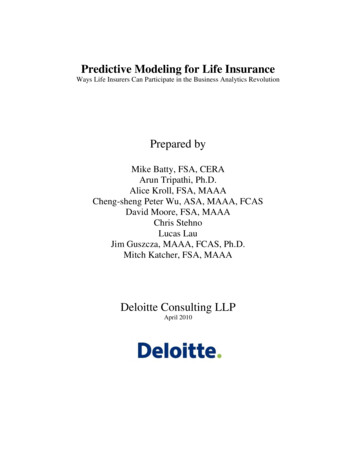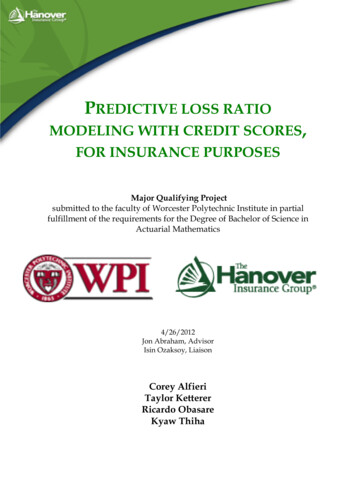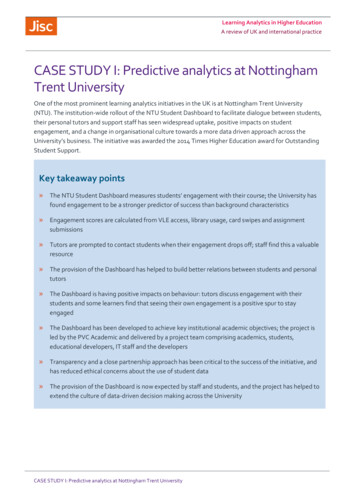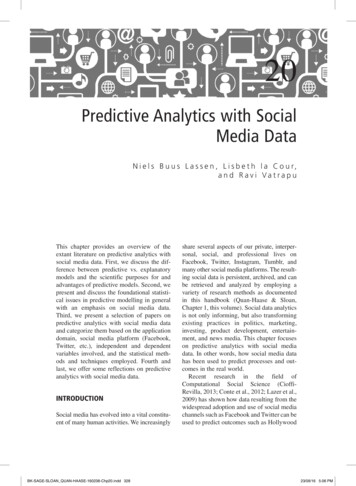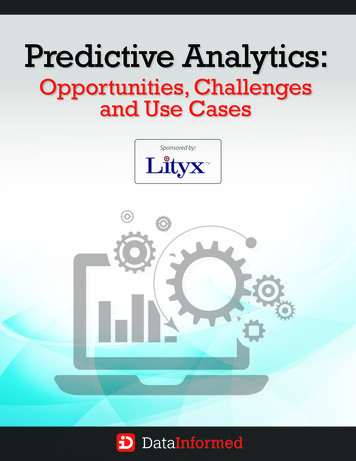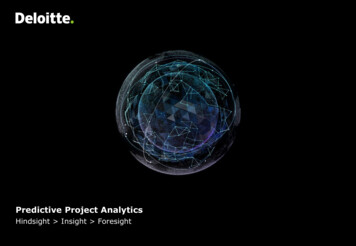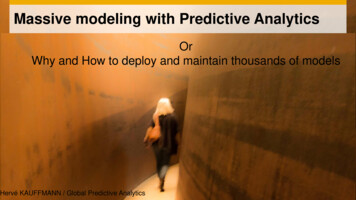
Transcription
Massive modeling with Predictive AnalyticsOrWhy and How to deploy and maintain thousands of modelsHervé KAUFFMANN / Global Predictive Analytics
Legal disclaimerThe information in this presentation is confidential and proprietary to SAP and may not be disclosed without thepermission of SAP. This presentation is not subject to your license agreement or any other service or subscriptionagreement with SAP. SAP has no obligation to pursue any course of business outlined in this document or any relatedpresentation, or to develop or release any functionality mentioned therein. This document, or any related presentationand SAP's strategy and possible future developments, products and or platforms directions and functionality are allsubject to change and may be changed by SAP at any time for any reason without notice. The information in thisdocument is not a commitment, promise or legal obligation to deliver any material, code or functionality. Thisdocument is provided without a warranty of any kind, either express or implied, including but not limited to, the impliedwarranties of merchantability, fitness for a particular purpose, or non-infringement. This document is for informationalpurposes and may not be incorporated into a contract. SAP assumes no responsibility for errors or omissions in thisdocument, except if such damages were caused by SAP s willful misconduct or gross negligence.All forward-looking statements are subject to various risks and uncertainties that could cause actual results to differmaterially from expectations. Readers are cautioned not to place undue reliance on these forward-looking statements,which speak only as of their dates, and they should not be relied upon in making purchasing decisions. 2016 SAP SE or an SAP affiliate company. All rights reserved.2
What is Predictive Analytics?Use HistoricalDATA to detectPATTERNPredict byexecutingPATTERN oncurrent DATAProbabilitiesValuesGroupsRulesControl &Maintain theQuality over time 2016 SAP SE or an SAP affiliate company. All rights reserved.3
The Predictive Process with SAP Predictive Analytics AUTOMATED MODESEMANTIC layer production isautomated thanks to DATA MANAGERModelManagementMODEL creation is automated thanks toMODELERMaintainQuestionMODEL Management and Consumptionare automated thanks to ipulationSemanticLayerAll steps of the process are ngResultsConsumptionModel Creation 2016 SAP SE or an SAP affiliate company. All rights reserved.4
is Fully Integrated in ITAll this is only possible because Predictive analytics uses RDBMS as DATA SOURCEDATA MANAGER Is where DATASETS are designed Pushes code to the RDBMS to produce the DATASET at a given timeMODELER Creates the model handling all technicalities Push code to the RDBMS to produce the resultsPREDICTIVE FACTORY Schedules model Control & Maintenance Schedules batch production of resultsDATA is not moved from RDBMS, results are produced in RDBMS 2016 SAP SE or an SAP affiliate company. All rights reserved.5
An Expert Mode to go FurtherAutomated mode has been designed for productivity : Automate Analytical data set generation Speed up models generation Industrialize models execution Automate models maintenance Generate documentationBeyond the Automated Mode, it is possible to use the more traditional Expert mode approach: Custom R-Code Predictive Analytics Libraries implemented in HANA 2016 SAP SE or an SAP affiliate company. All rights reserved.6
Massive Modeling needs AUTOMATIONSAP answer : Automated Mode is based on SRM (Structured Risk Minimization)SRM merges three steps into oneVariable selection1. Automated data preparation2. 3.Uses all available variablesVariable encoding – Nominal, ordinal, and continuousTarget optimized binning – creating meaningful value groups using SRM principlesMissing value handlingOutlier detectionEvent aggregation – by time, value, or sequence in Data ManagerAutomated model testing on holdout sample 2016 SAP SE or an SAP affiliate company. All rights reserved.7
SRM approach make it extremely powerfulAdding explanatory variables has potentially high benefits: Does not cause over-fittingMore variables can only add to the model qualityRandom variables do not harm quality or reliabilityHighly correlated explanatory variables do not harm the modelling process (multicolinearity)Efficient scaling with additional variablesFree of distribution assumptions: Normal distributions are not necessarySkewed distributions do not harm qualityResistant to outliersIndicates robustness of the model Prediction Confidence metric indicates if there are insufficient training examples to develop arobust model 2016 SAP SE or an SAP affiliate company. All rights reserved.8
Deploy Where and When it MattersProducing the results should take into account how they will be usedBATCH Offline campaigns Churn detection Customer knowledge ON THE FLY / REAL TIME when it makes sense Credit card fraud detection Online recommendations Call Centers Quality control Models are transformed into EXECUTABLE code in DATABASE (SQL) or in 3rd party environments (C , JAVA ) to be executed when andwhere it matters 2016 SAP SE or an SAP affiliate company. All rights reserved.9
Why building many models is importantExploration models Analyze data through statistical prism Control data consistency Validate an « a priori » business questionAll divisions of the company need answers Sales Marketing Finances Human Resources Logistic Pricing Fraud Production StrategyITOther KPIsSmall local storesIn most cases answering one question requires more than one model Heterogeneous population studied Multiple type of targets to be addressed 2016 SAP SE or an SAP affiliate company. All rights reserved.10
How to build many models : Massive ModelingIn most cases, building one global model has no sense: Stores are different Borders are different Products are different Customers are differentFor each question you need to define homogenous populations to analyze: Split the data in different populations thanks to a physical segmentation (eg : 1 store 1 model) Split the data in different populations thanks to a business rule segmentation (eg : regroup customersdepending on their purchase rate) Split the data in different populations thanks to a statistical segmentation (eg : clustering / supervisedclustering) 2016 SAP SE or an SAP affiliate company. All rights reserved.11
SAP Predictive Analytics answer: Segmented ModelingCreate and manage a set of models sharing the same settings as a single modelDefine the right granularity Products, Products per Stores, Type of Products per Store Stores, Stores per Town , Stores per Revenue Customers, Customers per Stores, Customers per baskets valueBuild the attribute for the chosen granularity If necessaryThe number of models will also depend on the type of analysis Classification Regression ForecastingTell predictive Analytics on which attribute build automatically the models 1.000 stores 1.000 models 100.000 couples product/store 100.000 models 2016 SAP SE or an SAP affiliate company. All rights reserved.12
Cox Communications: Supercharging Customer Relationships withSAP Predictive AnalyticsCompanyCox Communications Inc.HeadquartersAtlanta, GeorgiaIndustryTelecommunicationsProducts and ServicesCable entertainment andbroadband servicesEmployees50,000RevenueUS 15 billionWeb Sitehttp://ww2.cox.comChallenge Cox needed to increase sales and retain customers in multiple diverseregions around the country. Marketing tactics in one region were notas effective in others.Key Influencers Building models the traditional way took to long to meet the needs foreach region. Cox needed to understand the propensity of individuals tobuy new services in different parts of the country.How SAP PA Addressed the Problem It took the Cox data scientists an average of 4 weeks to develop onemodel per region for a total of 24. Automation allowed them to developmodels in a day or two. Productivity increased 24x. They were able togenerate 600 models with the same number of folks. Theseadditional targeted models facilitated campaigns tailored to individualproducts in each market segment.Results of implementing PA The specificity of the campaigns allowed increased upsell revenuesand churn reductions. Additional product sales to existing customers increased 14% The rate of customers leaving was reduced by 28%“With SAP Predictive Analytics we've increased the products soldper household by 14%.”14%More products per customerhousehold28%Reduction in customer churnrate80%Reduction in model creationtime24xGreater throughput for centralanalysts (from 24 to 600predictive models)Parimala Narasimha, Director of Marketing Science, Cox Communications Inc. 2016 SAP SE or an SAP affiliate company. All rights reserved.28969 (14/03) This content is approved by the customer and may not be altered under any circumstances.13
US Large Retailer: Data Driven CompanySAP Predictive AnalyticsUsers by Division260k models daily inproduction. At POS levelData analysis used forevery decisions 2016 SAP SE or an SAP affiliate company. All rights reserved.14
Eldorado: Boosting Sales Forecast Accuracywith the SAP Predictive Analytics SolutionCompanyEldorado LLCHeadquartersMoscow, RussiaIndustryRetailProducts and ServicesConsumer electronics anddomestic appliancesEmployees15,000Revenue 2.4 billion (2012)Web Sitewww.eldorado.ruObjectives Analyze data stored in the SAP 360 Customer solution from over 1.5million point-of-sale transactions for more than 420 product groupsand sales of over 8,000 products each month Improve forecast precision to boost sales and reduce inventory costsWhy SAP Trusted technology partner with a proven record of delivering successacross the industry Ability to further leverage real-time access to large volumes of dataalready available with the SAP NetWeaver Business Warehouseapplication powered by the SAP HANA platform and the SAPPlanning for Retail application Ease of use, precision of predictive models, and innovative automatedtools available with the SAP InfiniteInsight solutionFuture plans Migrate further SAP applications to SAP HANA, leveraging the fullpotential of in-memory computing technology Continue to expand and evolve the business using world-class ITsystems and innovation Other use cases: pricing and promotion analysis, store clustering,store location selection, marketing mix"SAP InfiniteInsight has given us a scalable approach to createaccurate forecasts across our business.“FastBuilding approximately 500predictive models a month, atask impossible with traditionalmodeling techniques thatrequired weeks or months tobuild a single modelFlexibleCreating forecasts forassortment planning, shelfreplenishment, pricing andpromotion analysis, storeclustering, store locationselection, and sales andpurchasing planningAccurateAchieving up to 82% accuracyin sales forecasts, a 10%improvement over priorforecasting techniquesElena Zhukova, Head of Analytics, Eldorado LLC 2016 SAP SE or an SAP affiliate company. All rights reserved.28825 (13/12) This content is approved by the customer and may not be altered under any circumstances.15
2016 SAP SE. All rights reserved.No part of this publication may be reproduced or transmitted in any form or for any purpose without the express permission of SAP SE or an SAP affiliate company.SAP and other SAP products and services mentioned herein as well as their respective logos are trademarks or registered trademarks of SAP SE (or an SAP affiliatecompany) in Germany and other countries. Please see ht/index.epx for additional trademark information and notices.Some software products marketed by SAP SE and its distributors contain proprietary software components of other software vendors.National product specifications may vary.These materials are provided by SAP SE or an SAP affiliate company for informational purposes only, without representation or warranty of any kind, and SAP SE or itsaffiliated companies shall not be liable for errors or omissions with respect to the materials. The only warranties for SAP SE or SAP affiliate company products andservices are those that are set forth in the express warranty statements accompanying such products and services, if any. Nothing herein should be construed asconstituting an additional warranty.In particular, SAP SE or its affiliated companies have no obligation to pursue any course of business outlined in this document or any related presentation, or to developor release any functionality mentioned therein. This document, or any related presentation, and SAP SE’s or its affiliated companies’ strategy and possible futuredevelopments, products, and/or platform directions and functionality are all subject to change and may be changed by SAP SE or its affiliated companies at any timefor any reason without notice. The information in this document is not a commitment, promise, or legal obligation to deliver any material, code, or functionality. All forwardlooking statements are subject to various risks and uncertainties that could cause actual results to differ materially from expectations. Readers are cautioned not to placeundue reliance on these forward-looking statements, which speak only as of their dates, and they should not be relied upon in making purchasing decisions. 2016 SAP SE or an SAP affiliate company. All rights reserved.16
May 19, 2016 · SAP Predictive Analytics answer: Segmented Modeling Create and manage a set of models sharing the same settings as a single model Define the right granularity Products, Products per Stores, Type of Products per Store Stores, Stores per Town , Stores per Revenue Cus
